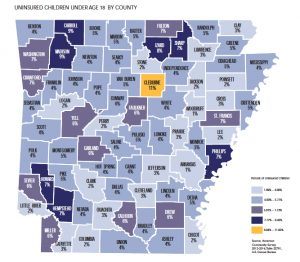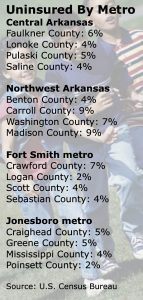Child uninsured rate falls to record 4.1% in Arkansas, coverage remains uneven
by March 14, 2018 7:08 pm 1,193 views

The Arkansas children’s uninsured rate fell to 4.1% last year thanks in part to Arkansas’ version of the Affordable Care Act. Marquita Little, health policy director with Arkansas Advocates for Children and Families, told Talk Business & Politics Arkansas gets a “B” for efforts to improve access to health insurance among children.
Little said 2017 was a milestone year, although the Finish Line report made available Wednesday (March 14) includes data through 2016. After eight years of pushing for immigrant children coverage, the state legislature approved the eligibility of Marshallese children for ARKids First and eliminated the five-year waiting period for legal status immigrants to apply for coverage, Little said of the milestones.
“It will be interesting to see what happens to the overall number this year with this change in policy,” Little said.
ARKids First, the state-run insurance program funded by the state and federal governments, covers around 450,000 Arkansas children. That’s 48% of the state’s children, according to the Kaiser Family Foundation. Arkansas’ 1st and 3rd Congressional Districts had the highest percentage of uninsured children, according to the AACF report.
• 1st Congressional District: 7,000 kids, 4% of population
• 2nd Congressional District: 6,000 kids, 3.5% of population
• 3rd Congressional District: 9,000 kids, 4% of population
• 4th Congressional District: 4,000 kids, 2% of population
Aside from geography, Little said there are also gaps in coverage based on ethnicity and income levels. She said the end goal is to have every child in the state insured, but as Arkansas gets closer to the finish line there are growing threats to forward progress.
THREATS AND CHALLENGES
Last year, there were threats to the funding of the Children’s Health Insurance Program (CHIP), which are federal dollars supporting ARKids. CHIP funding resurfaces every few years because the U.S. Congress has not made funding permanent. Successful attempts to dismantle the Affordable Care Act (ACA) also are a concern, Little said, because of the role it played in helping insure more Arkansas children and adults since 2013. Little said ACA helps provide coverage for the whole family which is something the agency supports because parents who see a doctor regularly for checkups are more likely to get routine medical care for their children.

Household income had a modest impact on access to coverage, according to the report. In households earning less than 100% of the poverty level, 5.7% of kids were uninsured in 2016. That fell to 4.4% for households between 100% and 200% of the poverty level. In households within 200%-250% of the poverty level, 5.1% of children were uninsured.
The report indicates the percentage of improvement is similar for the increased number of children covered under parents’ plans as the number recently covered by ARKids First.
The number of children covered by insurance is improving around most the state. Data shows Cleburne County, northeast of Conway in central Arkansas, is bucking that trend with 11% of children uninsured. It’s the only county showing double-digit uninsured rates. She said the number of children in that county without insurance is 532, but the county reports 44% of its children are covered by ARKids First, less than the state average of 50%. She said Census data doesn’t tell the whole story because the agency doesn’t know how many kids qualify for ARKids First. Little said rural counties like Cleburne tend to have between 50% and 60% of their kids enrolled in ARKids.
Other areas of concern are the higher-than-average numbers in Northwest Arkansas. Benton County reports nearly 3,000 children without coverage, or 4% of the child population. In Washington County, there are 3,729 kids without coverage, or 7% of that population. Little said Northwest Arkansas a great example of the complexity of coverage and barriers standing in the way. She said the immigrant population previously had a five-year waiting period and that likely added to the uninsured count in Northwest Arkansas. But given the region’s higher-than-average median income level, she said there are families knocked out of ARKids because they earn too much, but not enough to afford coverage elsewhere.

Little was uncertain as to why it has not been implemented but said it could budgetary.
The report said Hispanics have the highest level of uninsured children at 9.4%, regardless of income. That compared to 3.8% of non-Hispanic Whites, 1.5% of non-Hispanic Blacks and 4.9% of other ethnicities. Immigrant children also are more likely to be uninsured at 44% compared to 4.4% of native-born children. Little said there could language barriers at play which will require more education and outreach.
ROOM TO IMPROVE
“We have done some great things but we still have room for improvement. Last year there were technical issues with enrollment and other bureaucratic red tape related to funding. Enrollment needs to be simple and seamless and we are not there yet. But, the legislation to remove the 5-year waiting period for immigrants and covering the Marshallese kids were two big steps forward and should be impactful to the numbers going forward,” Little said.
She said the goal for all children to have insurance is eclipsed only by whole families having access to affordable coverage. She said neither the state nor nation is there yet. Little said it’s worth pushing forward because family-based health care is less burdensome financially, which allows more dollars for food, transportation and housing.
The report also looked at the impact of the ACA and found Arkansas’ adult population uninsured rate fell from 32% in 2013 to 11% in 2016. For households above the poverty level, the uninsured rate of adults decreased from 43.6% in 2013 to 18.8% in 2016.
Little said Arkansans have seen the benefits from the Medicaid expansion program, known as Arkansas Works, and other affordable coverage options available through the ACA.
